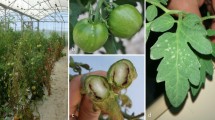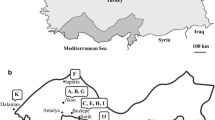Abstract
Bacterial canker caused by Clavibacter michiganensis subspecies michiganensis (Cmm) has been a threat to tomato production in Uruguay for several years. In this study, 39 Cmm strains were collected from several outbreaks and production areas in Uruguay, and were identified by molecular assays and pathogenicity tests on a susceptible cultivar of tomato. In addition, a TaqMan assay targeting a putative two-component system sensor kinase gene demonstrated good specificity with all strains tested and gave no false negative results. The first epidemiological study of Cmm in this country was carried out in order to elucidate the origin of outbreaks and sources of infection and dissemination of the pathogen. Strains from Uruguay showed high genetic diversity based on a Multi Locus Sequence Typing analysis of five housekeeping genes. This approach revealed 36 sequence types (STs) within a worldwide collection of 108 Cmm strains. Ten STs correspond to strains solely isolated in Uruguay, including eight novel STs for the subspecies michiganensis. This high diversity reflects the introduction of new strains from different origins that most probably results from seed importation. This study provides relevant information about the distribution and origin of strains causing bacterial canker in Uruguay and will pave the way for the establishment of preventive measures to control the disease.




Similar content being viewed by others
Abbreviations
- Cmm:
-
Clavibacter michiganensis subsp. michiganensis
- ST:
-
Sequence Type
- CC:
-
Clonal complex
References
Almeida, N. F., Yan, S., Cai, R., Clarke, C. R., Morris, C. E., Schaad, N. W., et al. (2010). PAMDB, a multilocus sequence typing and analysis database and website for plant-associated microbes. Phytopathology, 100(3), 208–215.
Baysal, Ö., Mercati, F., İkten, H., Yıldız, R. Ç., Carimi, F., Aysan, Y., & Teixeira da Silva, J. (2011). Clavibacter michiganensis subsp. michiganesis: tracking strains using their genetic differentiations by ISSR markers in Southern Turkey. Physiological and Molecular Plant Pathology, 75(3), 113–119.
Berendsen, S. M. H., Koenraadt, H., Woudt, B., & Oosterhof, J. (2011). The development of a specific Real-Time TaqMan for the detection of Clavibacter michiganensis subsp . michiganensis. Presented at the American Phytopathological Society - International Plant Protection Convention Meeting, Honolulu, Hawaii, 6–10 August 2011.
De León, L., Siverio, F., López, M. M., & Rodríguez, A. (2008). Comparative efficiency of chemical compounds for in vitro and in vivo activity against Clavibacter michiganensis subsp. michiganensis, the causal agent of tomato bacterial canker. Crop Protection, 27(9), 1277–1283.
De León, L., Rodríguez, A., Llop, P., López, M. M., & Siverio, F. (2009). Comparative study of genetic diversity of Clavibacter michiganensis subsp. michiganensis isolates from the Canary Islands by RAPD-PCR, BOX-PCR and AFLP. Plant Pathology, 58(5), 862–871.
De León, L., Siverio, F., López, M., & Rodríguez, A. (2011). Clavibacter michiganensis subsp. michiganensis, a seedborne tomato pathogen: healthy seeds are still the goal. Plant Disease, 95(11), 1328–1338.
DGSA-MGAP (Dirección General de Servicios Agrícolas, Ministerio de Ganadería, Agricultura y Pesca) (2009). Sub-estándar fitosanitario Mercosur. Sección III - Medidas Fitosanitarias. Requisitos fitosanitarios para Lycopersicon esculentum (tomate) según País de Destino y Orígen, para los Estados Partes. http://www.mgap.gub.uy/dgssaa/Normativa/Archivos/INTERN_ResGMC/ResDGSA16tomate.pdf. Accessed 26 Feb 2015.
Dreier, J., Bermpohl, A., & Eichenlaub, R. (1995). Southern hybridization and PCR for specific detection of Clavibacter michiganensis subsp. michiganensis. Phytopathology, 85, 462–468.
EFSA PLH Panel (EFSA Panel on Plant Health). (2014). Scientific Opinion on the pest categorisation of Clavibacter michiganensis subsp. michiganensis (Smith) Davis et al. EFSA Journal. doi:10.2903/j.efsa.2014.3721.
EPPO (European and Mediterranean Plant Protection Organization). (2013). PM 7/42 (2) Clavibacter michiganensis subsp. michiganensis. EPPO Bulletin, 43(1), 46–67.
Fatmi, M., & Schaad, N. W. (2002). Survival of Clavibacter michiganensis ssp. michiganensis in infected tomato stems under natural field conditions in California, Ohio and Morocco. Plant Pathology, 51(2), 149–154.
Feil, E. J., Li, B. C., Aanensen, D. M., Hanage, W. P., & Spratt, B. G. (2004). eBURST: Inferring Patterns of Evolutionary Descent among Clusters of Related Bacterial Genotypes from Multilocus Sequence Typing Data. Journal of Bacteriology, 186(5), 1518–1530.
Felsenstein, J. (2005). PHYLIP: Phylogeny inference package (Version 3.63). Seattle: Department of Genetics, University of Washington.
Fu, Y. X., & Li, W. H. (1993). Statistical tests of neutrality of mutations. Genetics, 133, 693–709.
Giovannoni, S. (1991). The polymerase chain reaction. In E. Stackebrandt & M. Goodfellow (Eds.), Nucleic acid techniques in bacterial systematics (pp. 177–204). Chichester: Wiley.
Gleason, M., Gitaitis, R., & Ricker, M. (1993). Recent progress in understanding and controlling bacterial canker of tomato in eastern North America. Plant Disease, 77(11), 1069–1076.
Guindon, S., Dufayard, J. F., Lefort, V., Anisimova, M., Hordijk, W., & Gascuel, O. (2010). New algorithms and methods to estimate maximum-likelihood phylogenies: assessing the performance of PhyML 3.0. Systematic Biology, 59(3), 307–321.
Hall, T. (1999). BioEdit: A user-friendly biological sequence alignment editor and analysis program for Windows 95/98/NT. Nucleic Acids Symposium Series.
Jacques, M.-A., Durand, K., Orgeur, G., Balidas, S., Fricot, C., Bonneau, S., et al. (2012). Phylogenetic analysis and polyphasic characterization of Clavibacter michiganensis strains isolated from tomato seeds reveal that nonpathogenic strains are distinct from C. michiganensis subsp. michiganensis. Applied and Environmental Microbiology, 78(23), 8388–8402.
Kawaguchi, A., & Tanina, K. (2014). Genetic groups of Clavibacter michiganensis subsp. michiganensis identified by DNA fingerprinting and the effects of inoculation methods on disease development. European Journal of Plant Pathology, 140(3), 399–406.
Kawaguchi, A., Tanina, K., & Inoue, K. (2010). Molecular typing and spread of Clavibacter michiganensis subsp. michiganensis in greenhouses in Japan. Plant Pathology, 59, 76–83.
Kleitman, F., Barash, I., Burger, A., Iraki, N., Falah, Y., Sessa, G., et al. (2008). Characterization of a Clavibacter michiganensis subsp. michiganensis population in Israel. European Journal of Plant Pathology, 121(4), 463–475.
Lasa, C. I., Abiko, K., Tezuka, N., Inaba, T., & García, S. (1981). Algunas enfermedades que afectan actualmente los cultivos de hortalizas en Uruguay. Investigaciones Agronómicas. Uruguay, Año, 2(Nro 1), 97–100.
Luo, L. X., Walters, C., Bolkan, H., Liu, X. L., & Li, J. Q. (2008). Quantification of viable cells of Clavibacter michiganensis subsp. michiganensis using a DNA binding dye and a real-time PCR assay. Plant Pathology, 57(2), 332–337.
Maiden, M., Bygraves, J., Feil, E., Morelli, G., Rusell, J., Urwin, R., et al. (1998). Multilocus sequence typing: a portable approach to the identification of clones within populations of pathogenic microorganisms. Proceedings of the National Academy of Sciences of the United States of America, 95(6), 3140–3145.
Milijašević-Marčić, S., Gartemann, K.-H., Frohwitter, J., Eichenlaub, R., Todorović, B., Rekanović, E., & Potočnik, I. (2012). Characterization of Clavibacter michiganensis subsp. michiganensis strains from recent outbreaks of bacterial wilt and canker in Serbia. European Journal of Plant Pathology, 134(4), 697–711.
Nunney, L., Elfekih, S., & Stouthamer, R. (2012). The importance of multilocus sequence typing: cautionary tales from the bacterium Xylella fastidiosa. Phytopathology, 102, 456–460.
Pastrik, K. H., & Rainey, F. A. (1999). Identification and differenciation of Clavibacter michiganensis subspecies by Polymerase chain reaction- based techniques. Journal of Phytopathology, 147, 687–693.
Pérez-Losada, M., Cabezas, P., Castro-Nallar, E., & Crandall, K. A. (2013). Pathogen typing in the genomics era: MLST and the future of molecular epidemiology. Infection, Genetics and Evolution, 16, 38–53.
Quesada-Ocampo, L. M., Landers, N. A., Lebeis, A. C., Fulbright, D. W., & Hausbeck, M. K. (2012). Genetic structure of Clavibacter michiganensis subsp. michiganensis populations in Michigan commercial tomato fields. Plant Disease, 96(6), 788–796.
Rozas, J., Sánchez-DelBarrio, J., Messeguer, X., & Rozas, R. (2003). DnaSP: DNA polymorphism analysis by the coalescent and other methods. Bioinformatics, 19, 2496–2497.
Sambrook, J., & Russell, D. W. (2001). Molecular Cloning a Laboratory Manual (3rd ed.). New York: Cold Spring Harbor.
Sen, Y., Feng, Z., Vandenbroucke, H., Wolf, J., Visser, R. G. F., & Heusden, A. W. (2012). Screening for new sources of resistance to Clavibacter michiganensis subsp. michiganensis (Cmm) in tomato. Euphytica, 190(2), 309–317.
Sen, Y., van der Wolf, J., Visser, R. G. F., & van Heusden, A. W. (2015). Bacterial canker of tomato: current knowledge of detection, management, resistance and interactions. Plant Disease, 99(1), 4–13.
Shimodaira, H., & Hasegawa, M. (1999). Multiple comparisions of log likelihoods with applications to phylogenetic inference. Molecular Biology and Evolution, 16, 1114–1116.
Smith, E. F. (1910). A new tomato disease of economic importance. Science, 31, 794–796.
Strider, D. L. (1969). Bacterial canker of tomato caused by Corynebacterium michiganense. A literature review and bibliography. North Carolina Agricultural Experiment Station Technical Bulletin 193.
Swofford, J. L. (2002). PAUP. Phylogenetic analysis using Parsimony.
Tajima, F. (1989). Statistical method for testing the neutral mutation hypothesis by DNA polymorphism. Genetics, 123, 585–595.
Tancos, M. A., Lange, H. W., & Smart, C. D. (2015). Characterizing the genetic diversity of the Clavibacter michiganensis subsp. michiganensis population in New York. Phytopathology, 105(2), 169–179.
Umesha, S. (2006). Occurrence of bacterial canker in tomato fields of Karnataka and effect of biological seed treatment on disease incidence. Crop Protection, 25(4), 375–381.
Van Heusden, A. W., Koornneef, M., Voorrips, R. E., Brüggemann, W., Pet, G., Vrielink-van Ginkel, R., et al. (1999). Three QTLs from Lycopersicon peruvianum confer a high level of resistance to Clavibacter michiganensis ssp. michiganensis. Theoretical and Applied Genetics, 99(6), 1068–1074.
Acknowledgments
This work was supported by CSIC I + D Grupos N° 652 and MSc. scholarship provided to V. Croce by the National Research Council in Uruguay (ANII).
We thank Enrique Verdier from DGSA-MGAP and Elisa Silvera and María José Montelongo from Agronomy Faculty for providing Cmm strains isolated in Uruguay; Ana Arruabarrena for helping in the isolations of strains from Salto; Sophie Bonneau for her useful advices to build the trees; Eliana Richard for technical support in figure editing; Federico Boschi and Diego Maeso for useful discussions; and Maria Inés Lapaz and Analía Sanabria for critically reviewing the manuscript.
Author information
Authors and Affiliations
Corresponding author
Electronic supplementary material
Below is the link to the electronic supplementary material.
Figure S1
qPCR amplification with primers designed by Luo et al. (2008) showing the results of six strains as an example. A. Fluorescence vs. cycles graph showing the inefficiency of the CMM probe by atypical curves (strains MAI 1001, MAI 1003 and MAI 1027). Strains showing typical curves (MAI1031, MAI1029 and MAI1039) are displayed in this graph in order to compare both kinds of curves. B. The six products sequences of the strains showed in (a) aligned and mapped with the probe shows a mismatch in the sequences of strains showing atypical curves. (GIF 80 kb)
Figure S2
Maximum likelihood trees based on partial sequences of genes atpD, dnaK, gyrB, ppk and recA. Bootstrap values higher than 50 are displayed at each node in red. (PDF 423 kb)
Supplemental Table S1
(DOC 167 kb)
Rights and permissions
About this article
Cite this article
Croce, V., Pianzzola, M.J., Durand, K. et al. Multilocus Sequence Typing reveals high variability among Clavibacter michiganensis subsp. michiganensis strains affecting tomato crops in Uruguay. Eur J Plant Pathol 144, 1–13 (2016). https://doi.org/10.1007/s10658-015-0738-0
Accepted:
Published:
Issue Date:
DOI: https://doi.org/10.1007/s10658-015-0738-0




